#anyway their catholic repression intrigues me
Text

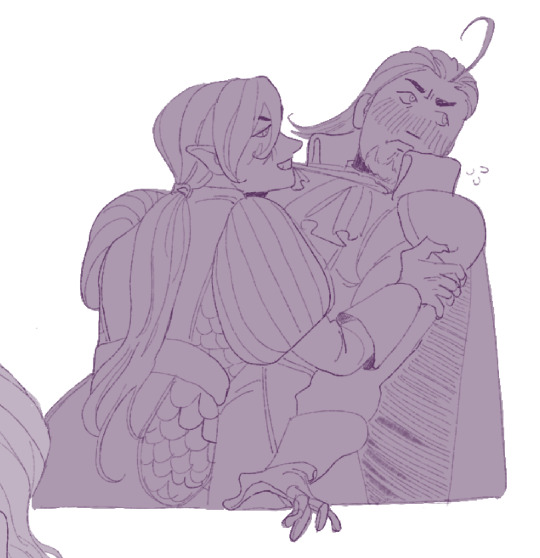
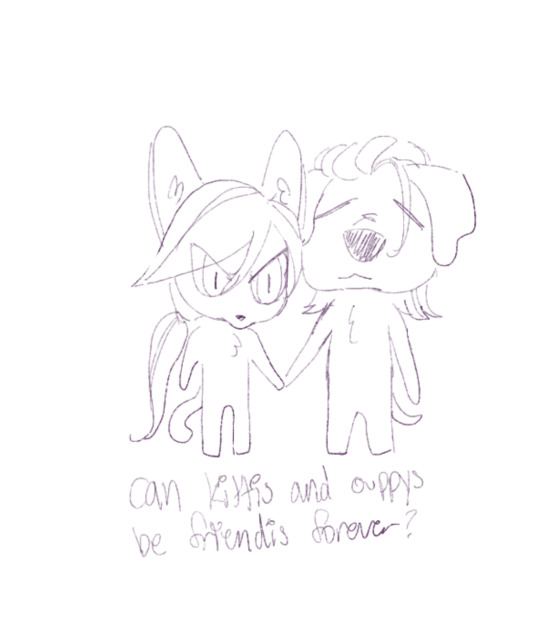
whats wrong old friend, you seem tense
#my art#dq11#hendrik#jasper#jaspendrik.?#henper…… iono#anyway their catholic repression intrigues me#henjasp
84 notes
·
View notes
Note
no no no don't leave! I'm so intrigued. That is wild that people would accuse their friends but most especially their family, because familial shame was like a real fucking big deal so you'd think people wouldn't want any black marks next to their names. I want to learn everything about what happened.
OMG, you have opened Pandora’s Box. So, for any poor unfortunate souls who happen upon this, this is a post about why the Andover witch trials are the true weirdos of 17th-century New England and NOT Salem. I have very marginal expertise in this beyond my Feelings.
So, to start, we need to understand what the fuck was happening in MA at this time. To put it (over)simply, Massachusetts Bay Colony is a theocracy run by religious extremists. The myth we’re taught in school that the Puritans were fleeing England because the meanie Church of meanie England was mean. As an Anglican, I will say we’ve done some shit but not that. The Puritans had an extremely repressive and strict society that tolerated little to no deviation in their social and religious norms (RIP the Quakers <3). Protestants of this period also tended to be wealthier and more literate than their Catholic counterparts and so these suspicions and feuds were more frequently taken to court. ALSO, the European colonists were facing increasing pressure because the indigenous populations from the north and the west were regularly raiding and fighting with them (I’ll give you, like, three guesses as to why.) and like also climate change was happening and it sucked for crops.
So, you have this pressure cooker of a society under a lot of external stress with a long, well-recorded history (in court documents) of how much they Do Not Get Along. 1692 happens. A bunch of girls, like young people tend to do in pressure cookers of society under a lot of external stress, begin to act out. And the way they act out is, of course, to accuse people of being witches. (Haven’t we all felt the urge?) The state courts get involved and the hysteria spreads across the settlements of along the North Shore and into…ANDOVER. Now the other hysteria outbreaks tended to be smaller, shorter, and more contained than what happens in Salem. In Andover, however, more witches were accused than in any other New England town including Salem Village and Salem Town. Which is INSANE.
Now, Salem has been the focus of so much research that we have a pretty clear understanding of why it happened. In the 70s, Boyer & Nissenbaum basically solved the case in their book Salem Possessed and redefined how we think about the witch trials. The people who were being accused were in opposing parishes, in opposition with a controversial minister (father of one of the afflicted girls), or had a history of legal disputes with the people who were accusing them. How do we know this? Puritans and their love of bringing each other to court!!! Otherwise, they were outcasts. It’s terrible but logical. In Andover, it starts out this way, pressure cooker, hatred of outcasts, the kit and caboodle—the first woman who was accused brought smallpox to Andover when she first moved which made her seem cursed and then the second woman accused was a childless widow (because her daughter had been murdered). Now this is where things get whackadoodle dandy, that second woman accuses a woman named Martha Carrier of being “The Queen of Hell” and trying to build a devil’s colony in Massachusetts and says that she knows of 305 witches that Martha converted to the devil. (Where the fuck 305 comes from no one knows). Now, people are like, “Holy shit, there’s like 300 witches in Andover!” Andover is a community of 600. 50% of the people in a community are witches?!?!!?! Well, obviously, it’s Martha Carrier’s entire family and friends but then who else?
There’s tremendous pressure to accuse someone or confess or accuse someone after you’ve confessed to throw suspicion off of yourself and so the accusations fly in Andover—children, family members. There’s one notable case of a mother being accused by her pre-teen daughter. And these defy the patterns that happen in Salem—there are regional lines in Andover between the north (which after this, will become North Andover) and the south but they don’t matter here. Where in Salem, the accusations were contained to the west of the community, an equal amount of people are accused in north Andover and south Andover. It's estimated that 80% of Andover's population at some point were in court because of witch accusations. It’s also made worse, when the judges bring the Salem afflicted girls to Andover to hunt witches. Now, the girls don’t know shit about Andover and so, I think you could imagine a scenario where the accusations that they are making there are…more…random than in Salem.
What else is weird about Andover is that the people petition to end the witch hysteria. In Salem, petitions were made for individuals but in Andover, the town as a whole is like, “What the fuck is going on?” and they end it themselves instead of waiting for the governor to end it which is basically what happened in the rest of the colony. There's also a crazy minister in this, too, but I don't know much about him tbh except that he was like, *insert flailing Kermit gif* "THANK GOD A WITCH CRAZE WHAT I'VE ALWAYS WANTED."
Anyway. It’s much more interesting to me than Salem because for the three million books and movies made about Salem, Andover’s is a much more psychologically peculiar case and additionally, more significant in terms of the numbers of people imprisoned. But, I have to stop writing because my veggie burger’s burning.
#i would rec Unobscured as a good podcast about the trials#i also love salem#would not be mad about living there#except on halloween#fuck that shit
9 notes
·
View notes
Text
just watched 1992 dracula last night and i have so many thoughts about the drac-mina relationship (🤢)
i know winona ryder was drawn to the movie in the first place because she was intrigued by victorian repression, and in a way mina's choice of dracula, the highly erotic vampire, is a rejection of those rigid norms that tell her not to be open about her sexuality. i'm in favor of women embracing their sexuality in this context, but so many things make me dislike it. first of all, the most glaring reason why mina being dracula's dead wife feels not at all like a feminist choice is that, abiding by the metaphor of vampirism and blood drinking as sexuality, in the book he effectively rapes her. simply rewriting that scene in the movie to one where she consents is a cheap move and one that seriously pisses me off. another thing, mina being dracula's dead wife, albeit her reason for choosing him, takes away the sense of choice a bit in favor of an expectation that she should be with him. while it is her choice to be dracula's wife, making this choice leads to it being her only character trait, something that directly contradicts her characterization in the book as a strong, smart woman who is a key part of stopping dracula. on that note, the idea of "stopping dracula" itself takes on an entirely new meaning in this movie, one that i find myself wrestling with. as opposed to an Us (British, heterosexual, Protestant, virtuous) vs Them (foreign, queer, Catholic-ish, sinful) conflict as per the book, dracula's threat here is much less external. on the one hand, completely changing dracula's motivation makes him feel like a completely different character; instead of the evil being on a quest for world domination, we get this pathetic dracula who follows mina around and laments that humans don't like him. in my opinion, villains can sometimes just be villains, there's no need to change that, especially when doing so ignores a great amount of the source material. on the other hand, part of what makes dracula in the book so evil is that he is part of the Them, that he's a projection of late nineteenth-century british prejudices. the movie's giving him an actual motivation besides "he's just evil" takes away these prejudices. i appreciate this attempt at taking the book and updating it for a more modern, progressive outlook on dracula, but as i said, it feels out of character, especially for a movie aiming to be the most accurate dracula. however, making a book-accurate dracula would mean painting all foreigners and queer people and sexually active people as evil too, so that's not the right way to go about it either; there has to be a middleground. all this is to say, dracula should be less tragic, tortured soul and more evil, but not if evil = sexuality and foreignness. anyway #notmydracula, by which i mean, sure, have your tortured romantic hero dracula headcanons but don't go around saying that that was in the book. also, the movie almost entirely got rid of dracula's queerness in favor of aggressive heterosexuality, which may be an attempt at not demonizing queerness, but seriously, this movie was so annoyingly straight especially when the book was not. dracula and mina remind me of those annoying het couples that are constantly making out and calling each other sickening pet names. i didn't proofread this in any way because i have no desire to. hope it makes sense love and light <3
#anyway please discuss with me#dracula#dracula (1992)#spent 40 minutes on this when i should've been studying#fang speaks#vampires#long post
3 notes
·
View notes
Photo



El Coyote
Introduction for non Spanish readers
For a quick summary, use a web translator to read the wiki article, for my own description, read on:
https://es.wikipedia.org/wiki/El_Coyote
As the name suggests, this was a postwar long series, of pulp western novels numbering about a hundred issues, by a Spanish author, a remake of the Zorro character of novel and film, in fact in the story the hero draws the inspiration from the example of the earlier hero and moved forward in time to the Far West times of the California Gold Rush and later decades (1849-1879). In fact they are the best Western novels I have read, and told from a Spanish perspective. El Coyote starts as a defender of the local Californian Spanish and indians against the abuses and violence of the American gringo invaders and criminals in the wake of the Gold Rush, and later on becomes a crime fighter, as law and order are established and the native Californians get equal status as US citizens, often helping American people and not just the Spanish speaking Californians, up to the point that despite his sympathies for the Confederacy, he strives to keep California loyal to the Union, if only to spare its population the ravages of civil war, and later on at one point renders a good service to President Ulysess Grant.
For a hack writer, Mallorquí, the author, was a very good writer with a great culture, knowledge of the history of the West and California, and a flair for character relationships, and a wide variety of plots other than the usual topics of Western films, including action packed shootouts, murder mistery, courtroom drama, and political intrigue to name a few. Since he wrote so many novels to pay bills, the quality is uneven. Some are great, others formulaic, and most of them just a entertaining, pleasant reading, in itself not a mean achievement.
About the character, the merit of Mallorquí is about making the Coyote a more complex character than the Zorro, and his public persona, that of wealthy, peaceful if not downright cowardly, bon vivant, and cynical landowner César de Echagüe and his family life as interesting as his heroic exploits as a masked avenger, combining in one man the duality of the Spanish character with its virtues and vices, half Quijote, half Sancho Panza.
Don Diego de la Vega is a fop, but it’s just an act to avoid suspicions while Don César de Echagüe, while also pretending to be a weakling, is a highly intelligent man, that makes him a hard realist and he sees the futility of the struggle against the new American order, but he fights injustices and abuses as El Coyote anyway out of a sense of justice and Christian morality but also as a thrill seeker in his youth, and driven by a death wish in his mid-life crisis after the death of his first wife while giving birth to his son.
Had Mallorquí been born in the USA he would have became famous, as it was, in his lifetime his books were published in other European countries and were very popular, of all places, in Finland.
These wonderful covers are from a reprint in the 1980s for nostalgic middle aged people that read them in their youth in the 1940s, and to save printing costs, they combined two novels in each volume. As a teenager I found the artwork gorgeous and the books mind blowing, and highly inspirational as they presented for me a Spanish hero as a counter to the American Hollywood culture that steamrollered over Europe, and on a personal level I was fascinated by one female character that appeared as one of the various lovers of El Coyote, an American adventuress that pretended to be a Russian princess made me feel intrigued and interested in that far away country and among other things lead me later in life to meet my Russian wife, who by a coincidence has the same name as the fictional princess.
It took me about twenty years to complete the collection as my older brother hadn’t bought them all when they were first reprinted, and I had to find them by chance throughout the years in flea markets and found the last ones thanks to the internet. Reading them in maturity, they don’t have the same impact as when I was impressionable uneducated teenager, and a few of them are formulaic and trite, but I still find them great reading, though I was shocked by the casual killing and the grisly realism of depictions of death, even though it doesn’t indulge in sadism, though torture is often mentioned as a matter of fact. Just like violence in the American Western movies, come to think of it.
Looking back, I must have been a bloodthirsty psychopath in my teens (so what has changed you may think). On the other hand these novels were written in the aftermath of the Spanish Civil War for a generation that had gone through war and mass political murders and repression so I guess readers, children included, were desensitized to killing and brutality back then. Though one thing that makes them apart from the American films and novels, is the strong moral values throughout. Not the American values of law and order and the Protestant work ethic, but Catholic values of justice and equality. El Coyote is a violent man that takes justice in his own hands, but also a Christian and there are strong injuctions against social divide, racism and exploitation of the poor by the rich.
And that’s all I can think of. I will try to scan and post more of these covers if there’s interest.
PS: dor some reason and due to the vagaries of color printing, the Mexican "charro" costume of the Coyote appears in these covers in a range of shades from purple to blue and with gold trimming. Actually both in the novels and the original period covers the suit is black, with silver piping, wich makes sense since the Coyote, as an outlaw usually acted at night and the black color made him a harder target. One has also to bear in mind that a eye mask and a sombrero were enough disguise at a time when there was no electric lighting and nobody could get a good look at his face.
26 notes
·
View notes
Text
Someone on Forbes said that The Midnight Gospel is “mind-expanding”
....
I’m going to fight my initial reaction to this, and be more charitable, even though it comes far from naturally to me.
If you found The Midnight Gospel mind expanding... take it as a starting point. Do not take it as an end point. The spirituality espoused in this show is... exceedingly basic. If you find it mind expanding, that just means you have found your first step. There is a lot more to explore, continue that exploration. Do not take this as the end all and be all. Continue to think, read more metaphysics and spirituality (and read about the people behind that. Aleister Crowley was a sex and repression obsessed jerkass idiot. He is not a person to base your spirituality on).
To find the Midnight Gospel mind expanding is to set foot in a puddle, and be blown away because you have never experienced water. And that’s fine. It’s not like I was born into spirituality and metaphysics. Hell, I was raised Catholic. I had a lot to learn, and, sure, I was fascinated by Crowley, in a way, when I first learned about him when I was, like, 12. Hell, I was a hardcore LaVeyan Satanist from 18 to my early 20s. I’m still a Satanist, but being far more intellectually curious than LaVey ever was, having matured far more than LaVey ever did, and learning more about spirituality and metaphysical concepts than LaVey ever did, I dropped the LaVeyan part a long time ago. I’ve probably been a non-LaVeyan Satanist longer than I was a LaVeyan Satanist.
Everyone starts somewhere. If your starting point in thinking about spirituality, and metaphysics and all life being interconnected is the Midnight Gospel... well, fuck, I can’t say it’s a worse starting point than what I had.
Just... don’t take it as the end point. Do not be wed to that idea of spirituality and metaphysics, take it as the puddle it is, and go find a tub, and then a pond, and then a lake, and a river and a sea. Keep experiencing more.
And if you’re interested, if you want to know more, if you saw something in the background world of Midnight Gospel that intrigued you and was not in anyway explained, I will make you an offer. Ask me about it, if you’d like. Ask me about what I find so basic about The Midnight Gospel’s spirituality. I will answer truthfully, I will go research something if you glommed onto some imagery I don’t know anything about, and I will be as charitable as I possibly can.
13 notes
·
View notes
Text
The Key to Understanding Deltarune: The Halloween Hack
So we’re currently in the middle of a 4000 year content hiatus
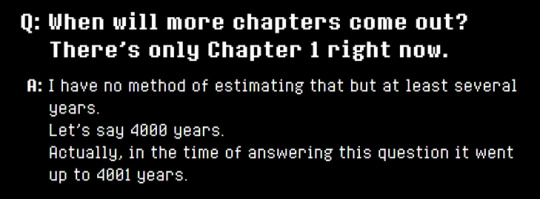
Which is unfortunate, because ever since the big iconic Halloween-day surprise demo drop, my brain has been rattling a baseball bat against the inside of my skull and chanting “CONTENT, CONTENT, CONTENT”
Undertale was like candy for the thematic analysis side of my brain. I still wake up in a cold sweat some nights going “fun value......he put a quantitative value on fun.....numbers going up.....”
I am desperate to know what kind of themes Deltarune is going to tackle. Can you effectively predict that from one (1) 3 hour demo? No. Does my brain care? No.
Which is what lead me to the wonderful world of intertextuality, or examining how a media text is shaped by other media texts
It started out with a kiss, how did it end up like this with me doing a playthrough of EarthBound, the video game that Toby has cited as his biggest inspiration for Undertale
That was fun & interesting (the “throwing away an emotionally engaging experience to grimly make Numbers Go Up” thing feels a lot closer to home after trying and failing to get the sword of kings), but it didn’t provide much insight into Deltarune, specifically. It wasn’t enough. I needed more. I was willing to dig into literally any intertext (except Homestuck, which no force on this earth can compel me to read :) )
anyway thats how I ended up playing Toby Fox’s high school fangame
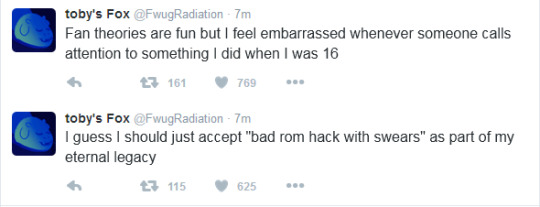
And somehow (sorry Toby) I walked out of there with an unironic theory (a game theory....if you will....): Deltarune is Toby’s adult reexamination of the Halloween Hack.
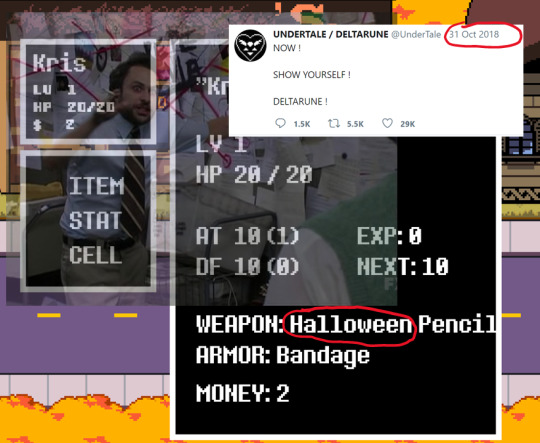
What is the Halloween Hack?
You know that thing where, like, people take the engine of a Pokemon game and edit it so there’s a new region and a bunch of new fakemon, and also There’s Swears Now
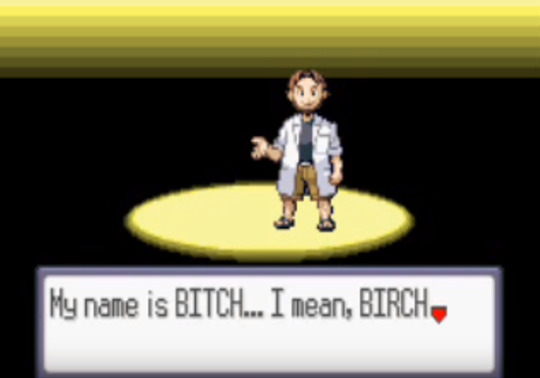
In 2008, Toby Fox entered a contest on an EarthBound fansite for the best Halloween-themed EarthBound hack
In one sense, reducing the Halloween Hack to a “bad romhack with swears” is a little bit of a disservice. There are some glimmers in there of a really affecting, thought-provoking game, and you can see some of the early blueprints of what would later become Undertale (“do video game ‘monsters’ really deserve to die” is a major theme, and the character of Dr. Andonuts was effectively split up into Alpyhs, Asgore, and Sans)
But it’s also. very much a fangame made by a 16-year-old.

You can read a basic summary of the Hack here. High school-age Toby wrote two pretty extensive analyses of his thought process behind the game. I’ll be referring back to them a lot, and I’d highly suggest giving them a read--Toby’s been so famously resistant to making any Word of God statements about Undertale that it’s kind of fascinating to see him being so candid
an extremely long and rambling examination of How This All Relates To Deltarune
The Halloween Hack opens in the town of Halloween Twoson. Twoson is one of the cites in EarthBound, and here it’s been painted orange. and there’s pumpkins now
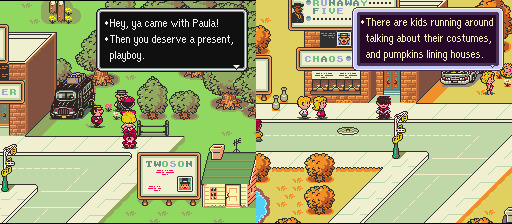
See, high school Toby had...a bit of a chip on his shoulder. In the Making Of notes, he explains that he was frustrated that “most people generally thought I was just ‘another funny guy’”. So he designed the opening of the game to seem unoriginally close to the original EarthBound--like “a regular, funny, lazy hack”--to lull players into a false sense of security before the horror elements set in.
Two interesting things there:
“Lazily, unoriginally close to the source game” sounds an awful lot like the Dark World segment of Deltarune
Halloween Twoson looks very visually similar to Hometown
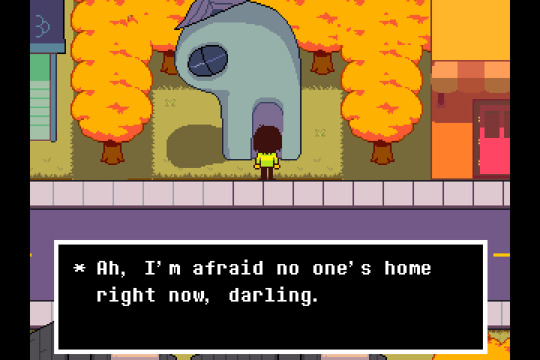
Toby’s description of Twoson also sounds pretty Hometown-esque:
The main impressions of Twoson that I wanted to give the player were: It's funny. It's a nice fall day outside. The person hacking this game is ridiculously lazy. It's a nice place to live. If you look at it a little closely, it's kind of claustrophobic.
And when does the horror kick in? When the player descends into the underground tunnels beneath the city.
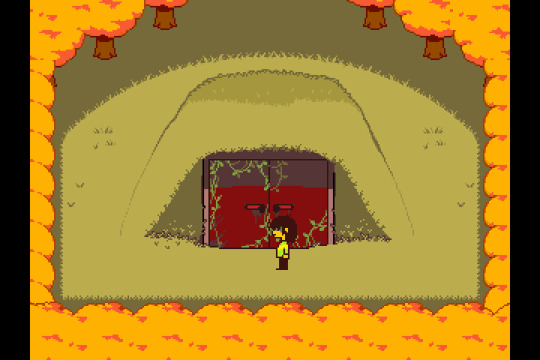
The “horror” in the Halloween Hack is, however, Pretty Not Good.
There’s a whole lot of the flavor text narrator (put a pin in that one) insisting “this is so scary. you’re so scared. your hands shake and your head throbs because you’re so scared.” There’s also a thing where the battle text keeps going “the shambling zombie BITES your HEAD OFF!!! (you lose 15 hp).”
I think the True Lab sequence in Undertale is a decent demonstration that Toby’s come a long way since then (and that Honey We’ve Got A Storm Coming :’) ). But you know what the Hack’s style of horror reminds me of?

My first thought when I beat the demo and saw this stinger was “this looks like an intentionally shitty creepypasta.” Now I wonder if it’s lowkey adult Toby poking a little fun at teenage Toby
The Halloween Hack is a game about railroading. It’s Spec Ops The Line before there was Spec Ops The Line.
According to Toby:
The main theme of this game is the lack of choice. There is really no choice in this game. From the moment you start to the moment you finish, you're destined to kill Dr. Andonuts. There are two endings, but they both eventually end up the same way. It's all a big joke on the player.
You know why there isn't a choice there?
Because you already chose to make Varik go into the door. You already chose to go forward. The only real choice, as Varik realizes at the end of the game, is to stop or keep going. By "stop" he means "turn off the game," and that's all you can do. Anything you play is your own fault for playing, and that's the only real choice you can make.
Interesting? Yeah. A little obnoxious? Also yeah.
That’s one of the criticisms people had of Spec Ops. "The atrocities we commit when we feel like we don’t have a choice” is an intriguing theme, but “~the only way to win is not to play~ [the game I worked hard on for the express purpose of people playing it]” isn’t a very satisfying conclusion.
Undertale, in direct contrast to the Hack, is all about choice. It earns the right to guilt you for the No Mercy Run by giving you every opportunity not to go through with it.
But even Undertale plays a little with the concept of railroading--you can’t stay with Toriel; you can’t spare Asgore in any of the neutral runs; you can’t save Asriel.
Now Deltarune seems to be returning full-on to the Hack’s “your choices don’t matter” premise. But it’s going to need to find something more insightful and satisfying to say about it.
Which makes me really curious about this:

If the Hack has a secondary theme besides railroading/lack of choice, it’s The Soul-Crushing Impact Of Internalized Homophobia.
The tragic antagonist, Dr. Andonuts, destroys his own life trying to repress his gay desire. He retreats into a dream world made of his neuroses and trauma, and he’s inevitably Otherized and murdered by the player. He’s something of a dark version of Alphys, who “disappears” into her lab without ever meeting and getting support from Frisk, Papyrus, and Undyne.
Undertale takes an opposite approach to its lgbt themes--the Underground is a utopia where homophobia and transphobia don’t exist. Everyone respects Frisk’s and Chara’s pronouns. Alphys finds solace and healing in her relationship with Undyne.
It’s a heartwarming growth from the despair in the Halloween Hack. And it’s a vision that’s been deeply meaningful to a lot of people. But that doesn’t mean that there’s no value in exploring issues of homophobia. 16-year-old Toby tried to do that, but...wasn’t exactly at a point where he was equipped to handle it with a ton of sensitivity and nuance.
(There’s. There’s a boss battle where you fight the physical manifestation of Andonuts’ gay repression. It’s a crotch. You fight a crotch.)
Some of the hints in the Deltarune demo, however--the Toriel Has Become Catholic thing; the fact that Alphys and Undyne haven’t met and Mettaton hasn’t been able to transition; the potential trans implications of choosing a name only to have it discarded for an assigned one (“you can’t choose who you are in this world”)--make me suspect that’s one of the themes that Toby will try to revisit from an adult perspective.
The Hack is interested in the idea of the flavor text narrator as a distinct, intelligent entity, whose thoughts and goals don’t always align with those of the player character or the player.
The Hack’s narrator makes a habit of dictating “your” emotions to you (you’re scared; you can sense ‘the monster’ and you want to kill it; etc). The narration starts to seem more and more unreliable, until, as Toby put it, “The narrator starts talking to you personally...rambling about incoherent things.”


At the game’s turning point, you’re given a yes/no choice to kill Dr. Andonuts. Choose yes, and the narrator (mockingly?) calls you a good person, describes the murder you commit, and then narrates what appears to be your (or their? or Varik’s?) psychological breakdown. Choose no, and the narrator tells you that’s not a real choice and redirects you back to the yes/no box. If you press the b-button to try and opt out of the choice (the game’s unofficial subtitle is “Press the B-Button Stupid,” and doing so allows you to follow Andonuts into his dream world), the narrator starts to panic, although the game ultimately ends the same way.
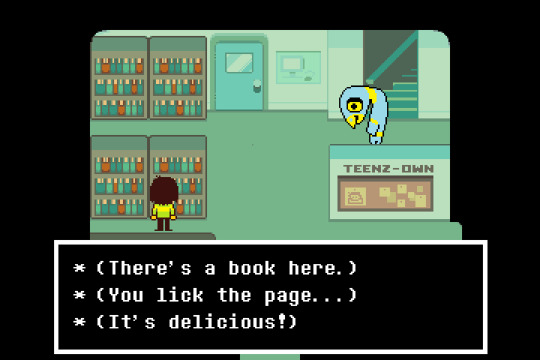
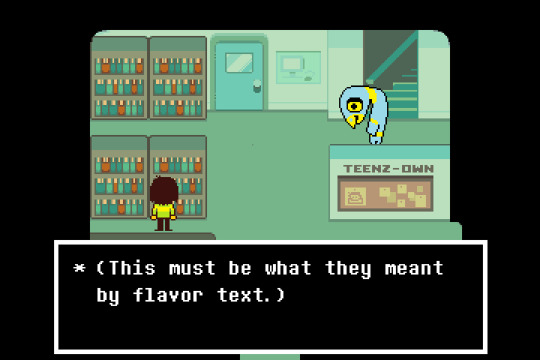
Not to NarraChara Real, but NarraChara Real
The Hack is also interested in the idea of the player character as a possibly-unwilling puppet controlled by the player (who in turn is controlled by the railroading/their need to beat the game).
According to Toby:
As you approach someone you've never met that you're labeling as a monster, your body pushes you forward to kill him. What's funny is that it's not even uncontrolled, it's really just the force of the player's controller pushing that little bounty hunter into murdering Andonuts. You might not realize it, but Varik is almost dead, and yet he can't stop moving because you keep pushing those buttons.
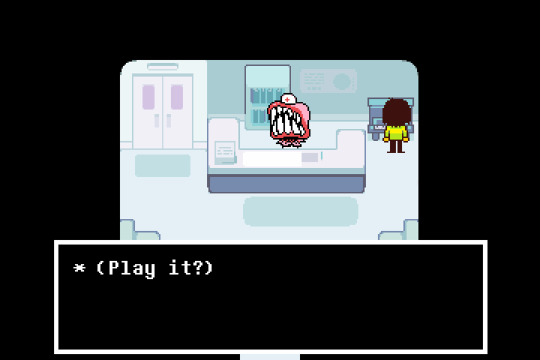
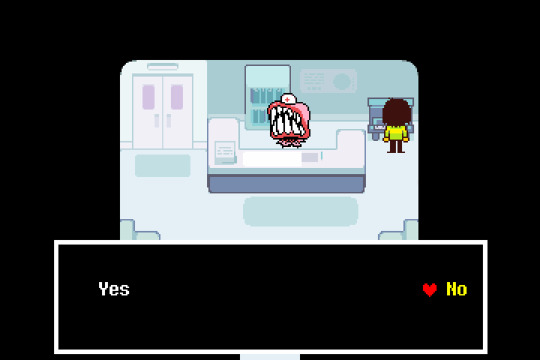
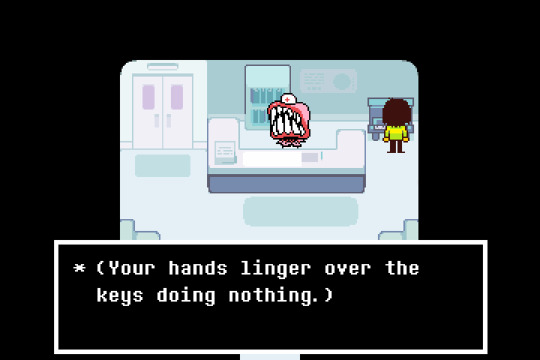
The Halloween Hack is, fundamentally, a nostalgic meditation on an existing game.
It’s a little obvious to say, but the Hack isn’t a standalone game. It’s a hack of EarthBound.
Toby writes:
EarthBound dominated my childhood, shaped my preteen years, and played a large role in molding me into the offbeat pseudohippie I am today. It gave me a sense of humor. It helped me learn how to read. Its lessons served as a basis for my sense of justice and courage.
But at age 16, Toby’s feeling about the game that had shaped him were a little mixed. He describes “the staleness of a fifteen-year-old video game” as one of his motivations for making the Hack.
In Deltarune, he (kind of hilariously) has Alphys parrot his teen-self’s “staleness” line:
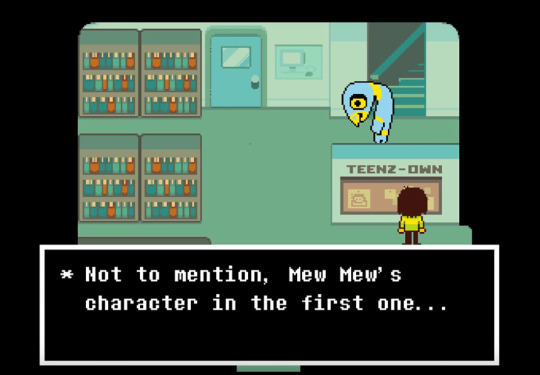
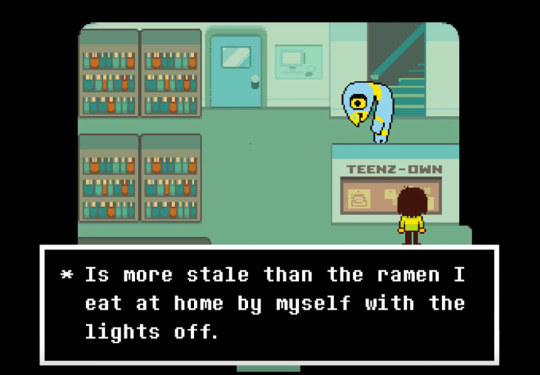
(I could write a whole meta just on the Mew Mew Kissy Cutie vs Mew Mew Kissy Cutie 2 thing)
Still, Toby’s nostalgia for EarthBound is essential to how the Hack operates. Earlier, I said there were glimmers of an thoughtful, affecting game buried in the “bad romhack with swears.” The most genuinely moving moment in the Hack, in my opinion, is the Onett sequence.
You wander though a faded, dream world version of Onett--the hometown from EarthBound--while a slowed down arrangement of the Onett music plays. Snatches of forgotten conversations appear on road signs. Various monsters from EarthBound follow slowly behind you, but don’t attack. The only battles are against creatures called “Remember Me?”
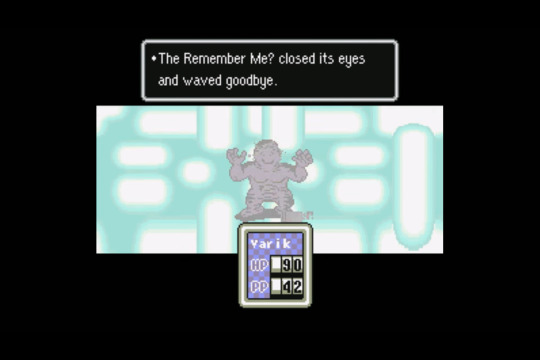
The EarthBound characters appear to recognize “Varik” as Ness, EarthBound’s protagonist--or are they recognizing you, the player, as the same person who played EarthBound once upon a time?
The one problem, of course, is that not everyone has played EarthBound. It’s a relatively niche game. The sense of remembrance and regret and loss in the Onett sequence is universal, but being shaped as a person by the specific video game EarthBound isn’t a universal experience.
But in the years since the Hack, Toby has created something with a wider reach than EarthBound. Something that can evoke that sense of memory and nostalgia in players. A familiar game that he can take apart, rearrange, and examine in an entirely different light.
He made Undertale.
And now he’s rearranging the pieces into Deltarune.

#deltarune#undertale#o and to clarify: i don't think the flavor text thing means that chara's evil#in fact i think deltarune's going to deconstruct that very reading of undertale#which is maybe a whole nother (hopefully much shorter) meta
196 notes
·
View notes
Photo



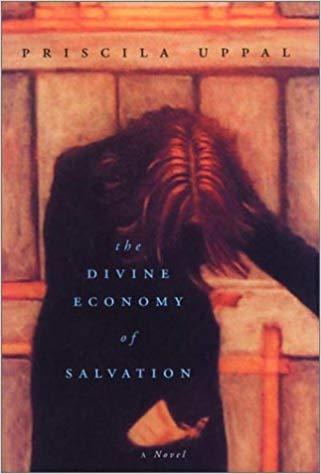
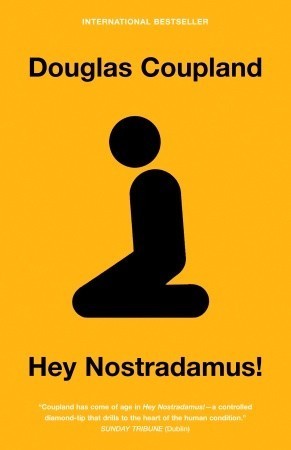

Books read in August 2019
The Female of the Species by Mindy McGinnis
You know I really like McGinnis and I’m trying to read more repeat books by women (the majority of books I read are definitely written by women but I don’t always follow up and read more of them I mean). McGinnis writes very dark and macabre YA and that’s exactly the problem I have with her books. I am, alas, too old to really enjoy books by teenagers.
The only other book I read of hers, A Madness So Discreet, was a Victorian era novel that turned into a bit of a crime thriller that dealt with crime and sexual abuse. The Female of the Species follows along the same lines even though it is set in a small town in present day (or near present day) America. Alex Craft is a teenager who’s older sister was raped and murdered and (it’s not TOO much of a spoiler since it happens in the first few pages but anyway skip to the next paragraph if you don’t want spoilers) she ends up murdering her sister’s killer when the police do nothing.
This book is really great at examining how misogyny is weaved into contemporary culture without being too preachy about it but then it sort of develops a dumbass love story. I don’t know if this is McGinnis being constrained by her publishers or the conventions of YA or if she actually enjoys writing like that but it just flattens so much of the great writing she’s been doing. I honestly feel like she could be a huge breakout writer for adults if she just aged up her female characters a little and fully embraced the darkness of her writing but maybe that’s unfair, maybe she doesn’t want to go there. She’s still a great writer and someone I would have totally been an unabashed fan of if I was still 16. Unfortunately I’m not.
The Day That Went Missing by Richard Beard
I really liked this one! I recommend with reservations though, it’s about trauma and grief, a memoir about how Richard Beard’s younger brother died in a drowning accident when he (the brother) was 9 and how his very British family repressed it. And boy did they repress it!
The book starts when Beard is in his mid 40s and finally starts to ask questions about his brother finally realizing that he repressed even basic info like the day his brother died and when he was born. From there he investigates the accident like it was a crime, interviewing his family about their memoirs and trying to track down other people on the day. The writing he keeps fairly simple and that’s good because the emotion is pretty vivid. Just a wonderful tribute to the brother he lost and an examination of grief, repression and acceptance.
Garbo Laughs by Elizabeth Hay
I liked this one but I also feel like no one else would so I hesitate to recommend... Set in the sleepy neighbourhood of Old Ottawa South (in Ottawa, duh) Garbo Laughs is about a movie obsessed writer in her 40s and her family, friends and neighbours following their lives over about two years. The novel is a bit Cranston-esque. Everyone is very similar (everyone is writing a book of some kind, everyone loves old movies and gets each other’s references). There is also a bit of romance mixed in in that the main character’s husband and the main character’s best friend have a deep attraction to one another which is quite sweet and romantic. This is not overly plotty nor is it really character based. More about a specific neighbourhood. It’s very gentle and sweet though, a nice and easy read. I am going to try to read some more by Hay, her other books are more acclaimed, but this was a nice little amuse-bouche that did enough to make me intrigued as to what else she has to offer.
The Divine Economy of Salvation by Priscila Uppal
More Canadiana. This one was also set in Ottawa. Set in a Catholic all girls school The novel flips between a “contemporary” setting, circa 2000 around when the book was written and 25 years earlier. In the present Angela H., a middle-aged nun, receives a candle stick which forces her to delve into her mysterious past at an all girl’s school. The novel has everything I like, friendship between girls, boarding school drama, sex, murder etc but it never really goes anywhere or really delves deeply into any of these subjects. The book is around 400 pages long so it should have the time to explore everything and yet half of the book is set in the contemporary time where almost nothing happens. The resolution to who is shaking down the nun is really dumb too. I could definitely see this being a really cool book if it had some tweaks but as it is it’s kind of flat and peters out.
Hey Nostradamus! by Douglas Coupland
Even more Canadiana! Coupland is a pretty big writer in Canada but he always struck me as a little... bro-y so while I wanted to give him a shot it wasn’t my highest priority. Anyway I came across this book while poking around the 2003 Canadian novels page on wiki after reading Garbo Laughs and this sounded really interesting so I picked it up.
The book is loosely inspired by the Columbine massacre and follows the aftermath of a school shooting through one couple and how they react to the death. It starts out pretty good and strong and while Coupland isn’t the flashiest writer he’s a really engaging one. The novel is set into 4 parts, each part set in a different year from a different person’s perspective. And I really wish it hadn’t used Columbine or school massacres as a hook. It almost felt... incidental to what the book became as I read along. Really the book is more about mercy and what that means and maybe if I had heard the book pitched to me that way I would have liked it more.
So all in all okay.
The Invention of Morel by Adolfo Bioy Casares
Well I knew my luck would have to run out eventually. NYRB Classics is an imprint that only republishes books that have fallen out of print or works of literature that haven’t been translated into English yet. I’ve loved every single book I’ve picked up from them most of which I’ve read blind and it’s really changed how I view literature because there are so many staggeringly amazing masterpieces that just aren’t even heard of and languish in obscurity that they manage to bring back. I usually pick my books from them blind and had yet to be disappointed until now.
TIoM is a novella and Jorge Luis Borges wrote the introduction which calls it perfect. It actually made a lot of sense to me that Borges liked this because like a lot of Borges the concept is incredibly interesting and dynamic but like Borges it leaves me cold.
Set on a remote island it deals with a fugitive who lands on a remote island and is surprised to see some French visitors arrive and disturb his peace. It’s very short but it took me forever to read because I didn’t care for it.
#currently reading#The Female of the Species#Mindy McGinnis#The Invention of Morel#Adolfo Bioy Casares#Hey Nostradamus!#Douglas Coupland#The Day That Went Missing#Richard Beard
3 notes
·
View notes
Text
It’s 3 am so u know what that means: meg is gonna write another dissertation about metal
Metal seems to be an attractive genre to people like me: raised catholic or christian, raised conservative, essentially raised repressed. Of course there are people that are exposed to metal when they’re little and they grow up with it, and I have a special kind of envy for those people, but.
Anyway I think the reason it’s an attractive genre to those kinds of people is because it’s so polar opposite to what we grew up learning. I went to fifteen years of catholic school. Sex was not a thing you talked about, ever, we all wore the same uniform and said the same prayers. It was like a factory spitting out teeny lil conformists with values from the ‘60s. No sex until marriage, not living with anyone until marriage, etc etc
Like. You see marilyn manson. He is a man. He wears corsets and ripped up pantyhose on stage, wears dark makeup and lipstick, and sings about sex, violence, and death: all shit we weren’t even allowed to think about without some kinda reprimand
And I know I’m making catholic school sound kinda like a merciless cult. But that’s how you start to see it when you’re out? It just produces sheltered kids who were afraid of any kind of misbehavior in my case. I was afraid of sinning and god hating me. I didn’t wanna go to hell. That’s not fair.
ANYWAY(sorry for the tangent) metal is by definition breaking the mold. Men have long hair and wear skirts and dresses and makeup and sparkles, women crop their hair and wear all leather or proudly talk about their sexuality. It’s so different from what we’ve learned all our lives that of course some of us are gonna be intrigued by it. It seems like it was made for kids like us. Some of those songs are pure catharsis but there’s a lot of truth and earnestness behind them. We resent people. We resent our parents and our communities for refusing to allow us to invite ourselves into a type of community that, although unconventional, would have made us happy a lot sooner. Maybe I would have wanted to kill myself less. Maybe I wouldn’t have fallen into self harm. Who knows? All I know is that I have it now, I can’t wait to keep exploring it, and I’m grateful it exists.
#the Wife opened my eyes#im 99% sure this doesnt make any sense#ill probs delete it tomorrow#anyway#night fam
2 notes
·
View notes
Photo

Aside from the egregores most likely being manifestations {"shadow selves" or "soul fragments" in shamanism; "thoughtforms of sin" in Christianity} of my own deeply rooted problems part of my depressive psychosis and PTSD, there is also this as food for thought - I was surprised to talk with another YYH fan having a series of crazy dreams involving her OC in a love triangle with Kurama and Karasu. Wild. But it did get me thinking, as she claims Karasu "indulges her dark side in her dreams" {yet claims it's not wish fulfillment, at all} - however, I can acknowledge my Crow did this for me, and I do have a repressed sexuality coming from a strict Catholic upbringing and all that I was made to be ashamed of; with Karasu and me, it is much like the song by the Arctic Monkeys that goes, 'Cos you're a good girl, and you know it - you act so different around me. Cos you're a good girl, and you know it - I know exactly who you could be' {I know this is a cover; however, I only know the Arctic Monkeys version as Alex Turner sounds like my Karasu when he sings! ♡} Subjects like wish fulfillment and the subconscious, all of that, is very intriguing - to me anyway! I love how the mind works, and am always in awe of how vast our subconscious goes. Talking with my egregores helps me unlock a bit of that, like Karasu helping me recover memories {exactly why I use this self-help method in my shamanism practice} aside from when they also {seemingly} teach me new things at the same time! :0 ♡ This fangirl definitely didn't strike me as being really big on mental health awareness, though. Just seemed to want to share her stories in her dreams, and ghost stories; which were interesting anyhow. =^^'= heh ···°··· #mentalhealth #mypersonaljourney #myspiritualjourney #shamanism #egregores #servitors #shadowselves #soulfragments #depressivepsychosis #PTSD ···°··· . . . And as I finish up another #mentalhealthawareness entry, I hear Karasu praise me with, 'You did good.'
#shadowselves#depressivepsychosis#mypersonaljourney#egregores#shamanism#myspiritualjourney#mentalhealthawareness#mentalhealth#servitors#ptsd#soulfragments
1 note
·
View note